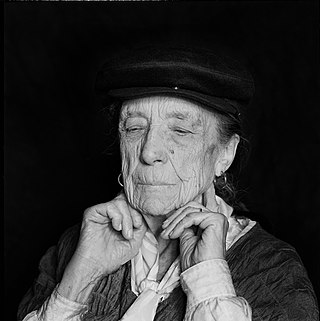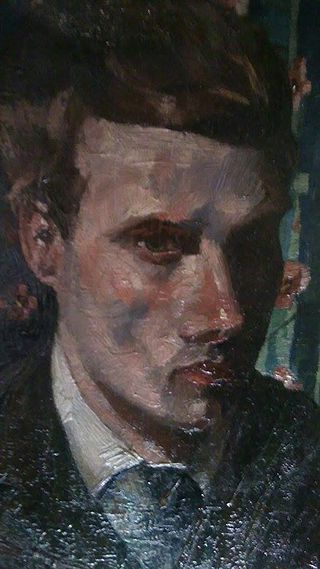Kate Whiteford OBE | |
|---|---|
| Born | 1952 (age 71–72) |
| Website | www |

Kate Whiteford OBE (born 1952) is a Scottish artist. [1] Her work includes painting, screen prints, textiles, land art and installations.
Kate Whiteford OBE | |
|---|---|
| Born | 1952 (age 71–72) |
| Website | www |

Kate Whiteford OBE (born 1952) is a Scottish artist. [1] Her work includes painting, screen prints, textiles, land art and installations.
Whiteford was born in Glasgow in 1952, [2] and studied at the Glasgow School of Art from 1969 to 1972, followed in 1974–1976 with a degree in Art History from the University of Glasgow. [2] In 1997 a British Council scholarship enabled her to travel to Italy where she was struck by the frescoes of Pompei and Herculaneum with their classical images and reduced range of colours. [2]
Whiteford is heavily influenced by archaeology, drawing inspiration from the local Pictish art. [3] Her work spans textiles, video, land art, prints and painting. [4]
One of her works, an untitled 1988 screenprint, is in the permanent collection of the Tate Gallery. [1] [5]
She designed Corryvrechann tapestry for the opening of the then Museum of Scotland in 1998. It measures 8 by 4 metres (26 by 13 ft) and was woven by Dovecot Studios. Since 2003 it has hung in Hawthornden Court in the now National Museum of Scotland. In 2015 the museum's conservation team took down the 90-kilogram (200 lb) tapestry and moved it to a freezer where it was kept at -30 degrees for a week to eradicate moths. [6] Corryvreckan, between the islands of Jura and Scarba, is the world's third largest whirlpool.
She has made a series of land art works, including her 2001 Shadow of a Necklace in the grounds of Mount Stuart House on the Isle of Bute. This comprised a drawing of a necklace, dug into a large lawn and filled with silver sand, planted in 2003 with grass seed which left a darker shadow on the lawn, gradually to fade away. It was inspired by a jet necklace found in a Bronze Age burial site at the site. [7]
In 1990, she represented Great Britain at the Venice Biennale as part of Three Scottish Sculptors along with David Mach and Arthur Watson.
Whiteford's work has also been included in other group shows, including,
In 2018, the Brontë Parsonage commissioned Whiteford to create a work about Emily Brontë’s hawk Nero, resulting in a video installation accompanied by a series of works on paper. [9]
Whiteford was appointed OBE in the 2001 Birthday Honours "For services to Art". [10]
The National Portrait Gallery holds a photographic portrait of Whiteford, by Heather Waddell, 1993. [11]

Louise Joséphine Bourgeois was a French-American artist. Although she is best known for her large-scale sculpture and installation art, Bourgeois was also a prolific painter and printmaker. She explored a variety of themes over the course of her long career including domesticity and the family, sexuality and the body, as well as death and the unconscious. These themes connect to events from her childhood which she considered to be a therapeutic process. Although Bourgeois exhibited with the abstract expressionists and her work has a lot in common with Surrealism and feminist art, she was not formally affiliated with a particular artistic movement.

Dame Elizabeth Violet Blackadder, Mrs Houston, was a Scottish painter and printmaker. She was the first woman to be elected to both the Royal Scottish Academy and the Royal Academy of Arts.

Sir Muirhead Bone was a Scottish etcher and watercolourist who became known for his depiction of industrial and architectural subjects and his work as a war artist in both the First and Second World Wars.

John Quinton Pringle was a Scottish painter, influenced by Jules Bastien-Lepage and associated with the Glasgow Boys.
Alison Watt OBE FRSE RSA is a British painter who first came to national attention while still at college when she won the 1987 Portrait Award at the National Portrait Gallery in London.
Jack Pierson is an American photographer and an artist. Pierson is known for his photographs, collages, word sculptures, installations, drawings and artists books. His "Self-Portrait" series was shown in the 2004 Whitney Biennial. His works are held in numerous museum collections.

Roni Horn is an American visual artist and writer. The granddaughter of Eastern European immigrants, she was born in New York City, where she lives and works. She is currently represented by Xavier Hufkens in Brussels and Hauser & Wirth. She is openly gay.
Louise Hopkins is a British contemporary artist and painter who lives and works in Glasgow, Scotland.

Goshka Macuga is an artist based in London. She was one of the four nominees for the 2008 Turner Prize.

James McBey was a largely self-taught Scottish artist and etcher whose prints were highly valued during the later stages of the etching revival in the early 20th century. He was awarded an Honorary Doctor of Letters by Aberdeen University.
Susan Mary Philipsz OBE is a Scottish artist who won the 2010 Turner Prize. Originally a sculptor, she is best known for her sound installations. She records herself singing a cappella versions of songs which are replayed over a public address system in the gallery or other installation. She currently lives and works in Berlin.

Norah Neilson Gray was a Scottish artist of the Glasgow School. She first exhibited at the Royal Academy while still a student and then showed works regularly at the Paris Salon and with the Royal Academy of Scotland. She was a member of The Glasgow Girls whose paintings were exhibited in Kirkcudbright during July and August 2010.

Karla Black is a Scottish sculptor who creates abstract three-dimensional artworks that explore the physicality of materials as a way of understanding and communicating the world around us.

Shilpa Gupta is a contemporary Indian artist based in Mumbai, India. Gupta's artistic practise encompasses a wide range of mediums, including manipulated found objects, video art, interactive computer-based installations, and performance.
Calum Colvin is a Scottish artist whose work combines photography, painting, and installation, and often deals with issues of Scottish identity and culture and with the history of art. He has had solo exhibitions at the Scottish National Gallery of Modern Art, Scottish National Portrait Gallery, and Royal Scottish Academy and has a number of works in the collections of the National Galleries of Scotland, Tate Galleries, and the British Council. He is also Professor of Fine Art Photography and Programme Director, Art & Media at Duncan of Jordanstone College of Art and Design, part of the University of Dundee.
Victoria Elizabeth Crowe is a Scottish artist known for her portrait and landscape paintings. She has works in several collections including the National Galleries of Scotland, the National Portrait Gallery, London, and the Royal Scottish Academy.

Compton Verney Art Gallery is an art gallery at Compton Verney, Warwickshire, England. It is housed in Compton Verney House, a restored Grade I listed 18th-century mansion surrounded by 120 acres (49 ha) of parkland which was landscaped by Lancelot 'Capability' Brown.
Claire Barclay is a Scottish artist. Her artistic practice uses a number of traditional media that include installation, sculpture and printmaking, but it also expands to encapsulate a diverse array of craft techniques. Central to her practice is a sustained exploration of materials and space.
Adrian Wiszniewski is a Scottish artist and one of the members of the New Glasgow Boys a group of artists who emerged from Glasgow School of Art and led the resurgence of Scottish figurative painting in the late 20th century. Other members of this group included the late Steven Campbell, who was a close friend of Adrian, Peter Howson and Ken Currie. Under the tutelage of artists like Alexander Moffat in the 1980s the four later went on the attain national and international status.
Sam Ainsley is a British artist and teacher, living and working in Glasgow, who was the founder and former head of the Master of Fine Art (MFA) programme at the Glasgow School of Art.